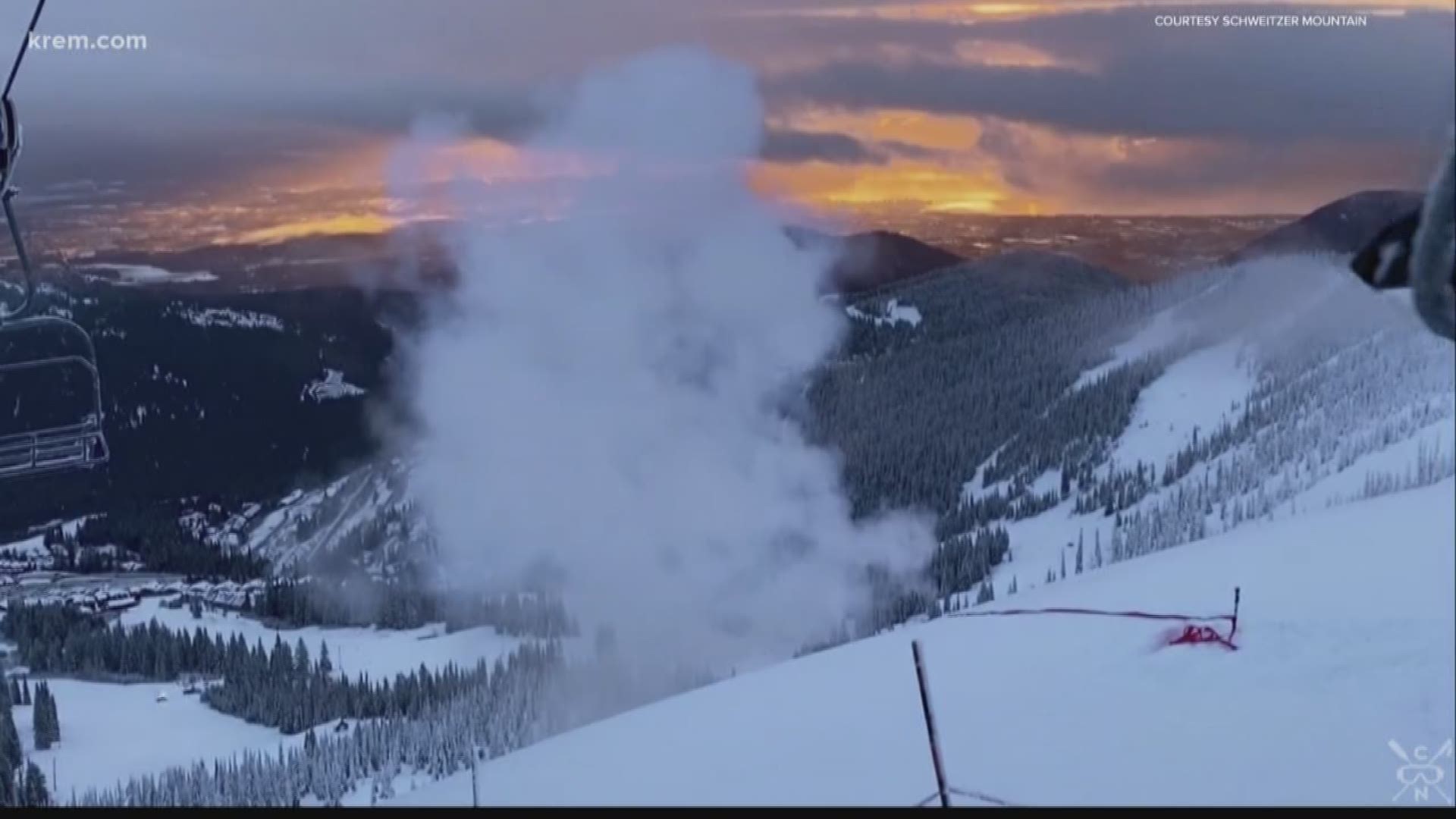BONNER COUNTY, Idaho — Long before skiers or snowboarders hit the slopes at Schweitzer Mountain, the resort’s Snow Safety Team is out checking conditions, and often using explosives to trigger controlled avalanches to stabilize the snow before the runs open.
Avalanche crews test snow moisture levels, carry out controlled explosions, check snow and wind levels, and train rescue dogs to help keep skiers, snowboarders and other people taking part in winter outdoor recreation safe.
Idaho Panhandle Avalanche Center Executive Director Jeff Thompson responded to the January avalanche on Silver Mountain that killed three people and injured four, and also wrote the preliminary report on the avalanche. He’s also a member of Schweitzer Mountain’s Ski Patrol.
Thompson said his snow safety crew has completed explosions to ease avalanche conditions about 20 times this season already.
“This season, we’re up to about 20 days, so we’re in a bit,” Thompson said.
But according to Thompson, even with the tireless work of crews to try to prevent avalanches, sometimes it’s just out of human control.
When Thompson isn’t patrolling the runs on Schweitzer, he teaches avalanche safety courses and works as an avalanche dog handler.
In January, he took 3-year-old Abby and another dog to Silver Mountain after the fatal avalanche.
“They’re trained to ski with us,” Thompson said.
Video shot by Montana-based rescue helicopter crew 2 Bear Air captured the frantic search for buried skiers after the avalanche.
Thompson said that, even with advanced technology available to search for stranded skiers and snowboarders, the rescue dogs are still the best tool to use.
“In this day and age of technology, this is still our best tool to use,” Thompson said of the rescue dogs.
Thompson added that Abby and another rescue dog were key in finding two of the people killed in the avalanche.
“They were both very helpful in finding the remaining victims when we got there,” he said.
The preliminary investigation into the deadly Silver Mountain avalanche found that a skier unintentionally triggered the avalanche, which ran more than 900 feet downhill. Thompson said this is the type of scenario he and his safety crew work constantly to prevent.
Tom Eddy, Schweitzer’s Snow Safety Team Supervisor, said the job his team does carries huge responsibilities, helping keep thousands of visitors safe every week.
“A big holiday weekend, we’re 5,000 [visitors] plus. Last year, we had our biggest day, 6,000 plus,” Eddy said.
To keep all of those people safe, Eddy said his team has to pay constant attention to detail, including temperatures and snow levels.
“So, we’re looking at new snow, we’re looking at winds overnight, we’re looking at temperatures,” Eddy said. “[We’re] looking back at what was happening at sweep at 3:30 the day before, just making sure that we’re keeping up with our terrain.”
Each day, Eddy weighs a sample of snow to measure the moisture content. The more water present in a snow sample, the higher the chance could be of an avalanche occurring.
Many of these variables — snowfall, temperature, winds and moisture content — help Eddy and his crew gauge the risks on the mountain each day. The work they do isn’t an exact science, but it is vital in the effort to keep skiers and snowboarders safe.
Over the last 10 winters, an average of 27 people a year have died in avalanches in the United States. These deaths aren’t just limited to skiers and snowboarders, as anyone who participates in outdoor winter recreation, from skiers to snowmobilers and mountain climbers, can be caught in an avalanche.
So far in 2020, the Silver Mountain avalanche is the deadliest avalanche incident in the country, according to the Colorado Avalanche Information Center.
That’s part of the reason why Thompson, Eddy and their colleagues wake up early and go out in conditions that are oftentimes brutal: To keep the ski runs that so many people love as safe as possible.
“Avalanches happen all the time at ski areas. It’s usually when we’re closed and when ski patrol is in controlled environment and can mitigate the hazard,” Thompson said. “Sometimes, Mother Nature has a mind of her own and no matter how much we think we can control that, and do what we can to make it not happen, there’s always a chance. Avalanches are an inherent risk of the sport.”
Statistics show that if you’re skiing in-bounds at a ski resort in the United States, your chances of being caught in an avalanche are low.
Experts say you assume far more risk if you plan to recreate in the backcountry where avalanche mitigation work is not done.
Thompson and Eddy say in that case, always ski with a partner and have the proper equipment: an avalanche transceiver, a shovel and probe.
They both also recommend checking the avalanche forecast to gauge the potential dangers.
Have a tip for our KREM investigators? Send an email to our investigative team at investigators@krem.com
The video below is a behind-the-scenes look at the making of this story.

